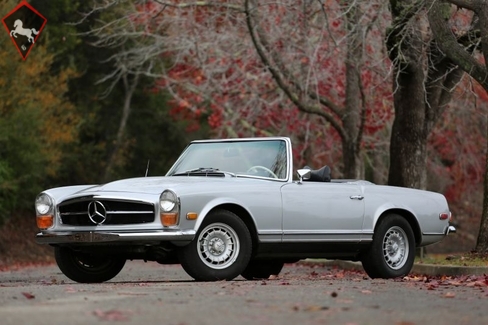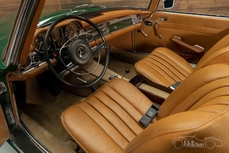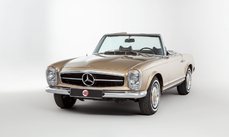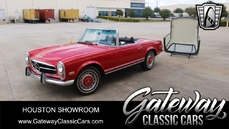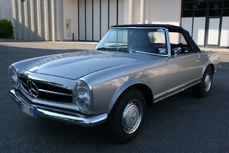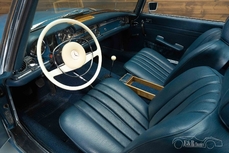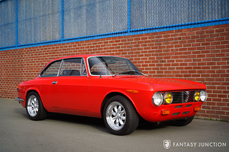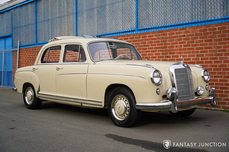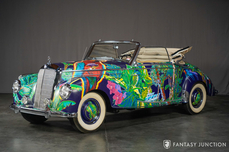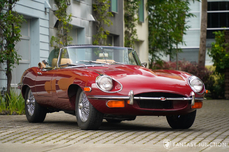Mercedes-Benz 280SL w113 2.8 liter inline-6 no. 130983-10-004759 1970
General description :
1970 Mercedes-Benz 280SL Convertible
s/n 11304410012217, Engine no. 130983-10-004759
Silver with Black Leather
After more than a century of superb automotive craftsmanship, Mercedes-Benz continues to be heralded as one of the premier automobile innovators, delivering vehicles of superior performance and optimum luxury. During the 1950s, decades of racing achievement and luxury refinement matured dramatically as US market growth encouraged new models, further endearing the brand to new and dedicated customers.
The mid 60s proved to be a rapidly changing time for sports cars. The budding 230SL was slated to replace both the 190SL and the iconic 300SL – an ominous task as the 300SL was a performance brute, but the 190, was nearly the opposite. The 230SL delivered perfectly, proving immediately appealing to customers seeking a charming and sporty car with clean styling and captivating details, but also offering spirited performance. The clarity and simplicity of design continued under the hood with technical advancements including Bosch fuel-injection, overhead-cam six cylinder engine, and syncromesh transmission, all of which delivered reliable performance. A convertible top, and substantial trunk space allowed for elegant presence and practical traveling, even over long distances. Among the many features offered in the car, several innovative safety aspects were incorporated into the unique body design including being the first sports car with a rigid passenger cell and designated crumple zones, industry standard today, but thoroughly new for a sports car in 1963.
This wonderful 1970 280SL represents the culmination of years of development and refinement of this iconic series Mercedes-Benz. The most notable improvement being the upgraded 2.8L engine delivering 170hp. Originally built in August 1969, with options including Frigiking A/C, US specifications, Left side exterior mirror, and Becker Gran Prix radio. The silver over black car was delivered to Phil Smart Mercedes-Benz in Seattle, Washington, and sold new to James P. Crooke of Seattle, WA on October 13, 1969. Four days later with just 869 miles the first of many documented services is performed at Phil Smart, stamped and initialed in the original service booklet included with the car. In 1972 the car was sold to the second owner, a Kirkland, Washington resident, who continued to enter the service record book along with other information up until 1986 when the car had logged 121,163 miles. The car remained in the Seattle area until the current owner purchased it in 1999 and imported it to Canada, BC. During his ownership the car was properly cared for including completely stripped to bare metal and repainted in factory correct silver in 2004. At this time a new top was fitted and the chrome was redone along with a white steering wheel installed (original black one comes with the car). Recently, $1,800.00 in service work was performed on the car including new points, adjusting the throttle linkage and fuel mixture, and adjusting the dwell and timing. Both front brake hoses were replaced, new pads, a new left front caliper was, and new exhaust hangers were installed.
Today the car presents as a very nice combination of original and partially restored example of a high quality driver 280SL with great options. The paint is in very nice condition overall with high gloss and quality finishing in all areas. The paint was applied with care to all inner surfaces, edges, corners, and trim, tending nicely to areas under the hood and the cowl insulation pad. Critically important on these cars are the original fenders and hood, particularly evidenced by the spot welds revealed in these areas. Here, the original front fenders and the area inside the grille under the hood show their correct factory spot-welds. Further validating the original front fenders, the inside front fender ridges are evident and crisp on both sides. The doors shut very well and retain good panel gaps. The hood and trunk also exhibit tight fit and closure. The chrome throughout is in very good condition, with nice luster and clean, bright reflections. All lenses, lighting, and glass are in very good condition with no significant chips or marks on the beautiful windshield. The black canvas convertible top is nicely tailored with a clear and taut rear window with excellent top bow tailoring and fabric welting on the underside of the top. The car comes with the distinctive “Pagoda Roof” hardtop, which is painted silver to match the car. The white headliner is in good original condition showing some yellowing at the windshield header and along the edges. The exterior presentation overall is handsome, with proper stance, smooth bodylines and a nicely finished set of cast wheels.
The interior, a Mercedes-Benz hallmark of quality materials and fine finishes, echoes throughout the cabin. The dash is nicely preserved with very clean instruments and recently redone wood trim. Of particular note is the Frigiking A/C unit (which blows, but not particularly cold) and is nicely detailed underneath the dashboard. The interior shows slight bagginess in the door panels, some wear in the headrests, and lightly used carpeting. Drivable and enjoyable for regular use, the interior is particularly delightful in the contrasting color against the vivid silver paint.
The engine compartment is nicely detailed and properly presented with correct parts, factory components, and updated lines, hoses, and electrical as needed, however not detailed to show standards. The trunk is clean and nicely finished with quality materials and very nice carpeting.
The car starts easily and idles smoothly, having been thoughtfully used over recent years and recently serviced. Driving manners are as expected for a nice solid example with a smooth gearbox and responsive clutch pedal. The ride engineering, disc brakes, and responsive suspension create a nice balance and composed power delivery for two occupants, with plenty of luggage space for refined touring. The floor pan, trunk floor, and undercarriage appear solid and straight, showing evidence of general but careful use. The car is offered with a complete set of factory owner’s books, reference manuals, jacking equipment, a host of previous service records, and the original black steering wheel.
This is a wonderful opportunity to acquire a driver ready 280SL. Finished in great colors with optional A/C, this handsome and iconic car is ready for enjoyable driving, touring with a friend, or overnight adventures. With a few suitcases safely stored and the top down, this 280SL will eagerly consume highways or side roads, leading to new discoveries and joys that only a classic Mercedes-Benz can deliver.
http://fantasyjunction.com/cars/2062-Mercedes-Benz-280SL-2.8%20liter%20inline-6
1970 Mercedes-Benz 280SL w113 2.8 liter inline-6 no. 130983-10-004759 is listed sold on ClassicDigest in Emeryville by Fantasy Junction for $84500.
Car Facts
Car type : Car Make : Mercedes-Benz Model : 280SL w113 Model Version : 2.8 liter inline-6 no. 130983-10-004759 Engine size : 2.8 Model Year : 1970 Sub type : Convertible Location : Emeryville
Sold
Seller Information
Sold
People who viewed this Mercedes-Benz 280SL w113 also viewed similar Mercedes-Benz listed at ClassicDigest
Other cars listed for sale by this dealer
About Mercedes-Benz
In the annals of automotive history, the journey of Mercedes-Benz is a tale that unfolds with the ingenuity of its founding pioneers. In the year 1886, Karl Benz crafted the Benz Patent Motorwagen, a creation that would go down in history as the world's inaugural automobile. Unbeknownst to him, this moment marked the genesis of what would evolve into the most illustrious premium car manufacturer globally. The financial underpinning of this pioneering venture, interestingly, was provided by Karl Benz's wife, Bertha Benz, demonstrating a remarkable partnership that would set the tone for Mercedes-Benz's legacy.A parallel narrative emerged not far away, as Daimler-Motoren-Gesellschaft, founded by Gottlieb Daimler and Wilhelm Maybach, entered the scene. In 1901, they unveiled their automobile under the now-famous moniker "Mercedes," meaning "godsend" in Spanish. This name was bestowed upon the car at the behest of Emil Jellinek's daughter, the distributor for Daimler-Motoren-Gesellschaft. The wheels of innovation were set in motion.
Fast forward to 1926, a pivotal year that witnessed the merger of Daimler with Benz & Cie., culminating in the birth of Daimler-Benz. The amalgamation saw the adoption of "Mercedes-Benz" as the distinguished trademark for their automobiles, fusing the legacies of two visionary entities into one.
Contrary to perceptions of conservatism, the trajectory of Daimler-Benz unfolds as a chronicle of industry firsts. From the introduction of the honeycomb radiator to the float carburetor, and the pioneering implementation of four-wheel brakes in 1924, Daimler-Benz consistently pushed the boundaries of automotive innovation. The diesel-powered Mercedes-Benz 260 D in 1936 marked the inception of diesel engines in passenger cars. The iconic Mercedes-Benz 300SL Gullwing made history as the first car with direct fuel injection, albeit the Gutbrod's tiny 2-stroke engine can claim precedence.
Safety innovations became a hallmark, with Béla Barényi's patented safety cell design in the "Ponton"-models in 1951, featuring front and rear crumple zones. The W116 450SEL 6.9 saw the introduction of the Anti-Lock Brake system (ABS), another pioneering safety feature. From the first production airbags and beyond, the legacy of "firsts" continued to be etched into the fabric of Daimler-Benz.
Over its centennial journey, Mercedes-Benz has not merely produced cars but has sculpted automotive icons. The SSKL, 710 SSK Trossi Roadster, 770K Grosser, 540K Spezial Roadster, 300SL Gullwing, w100 600 Pullman, w111 280SE 3.5 Flachkühler, w113 230SL Pagoda, w109 300 SEL 6.3, and w201 2.3-16 Cosworth stand testament to the brand's commitment to engineering excellence.
The roaring Silver Arrows, or "Silberpfeile," including the W 25, W 125, W154, W165, and W196, created a legacy of dominance on the racetrack. These machines were not merely cars; they were expressions of precision, speed, and an indomitable spirit that left their competitors in the dust.
As Mercedes-Benz marches into the future, it does so not just as an automaker but as a custodian of a legacy, a torchbearer of innovation, and a beacon of automotive excellence. The road ahead is sure to witness the continued fusion of cutting-edge technology, timeless design, and an unwavering commitment to setting new standards in the world of automobiles.
One luminary figure who left an indelible mark was Béla Barényi, often heralded as the "father of passive safety" for his pioneering work in safety engineering. His patented safety cell design, featuring front and rear crumple zones, became a hallmark of Mercedes-Benz's commitment to occupant safety, setting new standards that reverberated throughout the automotive world.
Moving through the chronicles, the collaborative genius of Wilhelm Maybach, alongside Gottlieb Daimler, laid the foundation for Daimler-Motoren-Gesellschaft. Their innovations not only birthed the first Mercedes but established a culture of relentless pursuit of technological excellence that remains integral to Mercedes-Benz's DNA.
In the post-merger era of 1926, Ferdinand Porsche emerged as a prominent figure within Mercedes-Benz. His work on the Mercedes-Benz S-Type, a supercharged race car, garnered acclaim and set the stage for a legacy that extended far beyond the marque. Porsche's impact would later extend to his eponymous company, but his influence at Mercedes-Benz during those formative years was pivotal.
As the 20th century progressed, the legendary Rudolf Uhlenhaut emerged as a key figure. Uhlenhaut, an accomplished engineer and the driving force behind the iconic Silver Arrows, played a crucial role in Mercedes-Benz's dominance in motorsports. His engineering prowess and attention to detail were instrumental in creating some of the most formidable racing cars of the era.
In the latter half of the century, figures like Bruno Sacco, the head of design at Mercedes-Benz from 1975 to 1999, left an indelible imprint on the brand's aesthetic identity. Sacco's design philosophy, characterized by clean lines and timeless elegance, shaped iconic models like the W126 S-Class and the W201 190E, solidifying Mercedes-Benz's reputation for luxury and sophistication.
The narrative would be incomplete without acknowledging the contributions of engineers like Hans Scherenberg, whose leadership in the 1970s ushered in a new era of technological innovation at Mercedes-Benz. Scherenberg's tenure saw the development of groundbreaking technologies, including the Anti-Lock Brake system (ABS) and the introduction of airbags in production cars.
